Beetles
No-one with an eye for the natural world can have failed to see a beetle - for they are everywhere. Beetles form the order Coleoptera and account for something like one fifth of all living species on Earth and well over 20,000 species have been described for North America. With such a huge and diverse group - they include weevils, Lady Beetles, Fireflies and more - it is impossible to include them all here. However, this site attempts to cover the majority of common species that may be easily encountered in the Cape May area. Beetles go through a complete metamorphosis, with larvae that may look white and caterpillar-like and be relatively inactive vegetarians, to larvae that have fully-functioning legs and actively seek out invertebrate prey. Many species are considered pests of crops (especially the longhorns that attack living trees) while others are voracious feeders of insects we may consider to be garden pests. In size, beetles range from tiny creatures that require a hand lens to study, to some of our largest insects at some two and a half inches (60mm) long.
(For a list of all beetle species on the site, click here)
Use the photos below to narrow your search to a group of beetles, then click on the picture to go to the next stage.
 |
Ground Beetles
A large and difficult group of beetles; most ground beetles are active predators, with many species being most active at night. Most species are predominantly black in color with often reddish or brownish legs. Some species have metallic green or purple reflections. As the name suggests, these are mostly ground dwellers, but some will enter buildings and a few hunt on tree trunks.
|
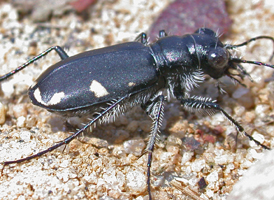 |
Tiger Beetles
These ground-living beetles can often be abundant on open, sandy ground. They are fierce hunters of other invertebrates and are active throughout the warm days of summer. Unlike most beetles, they take to the wing readily if approached, making them often difficult to study closely. They may be dark brown or blackish (often with pale markings), or metallic green.
|
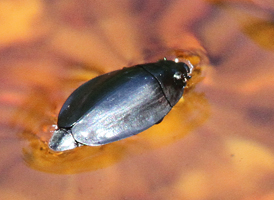 |
Whirligig Beetles
Small, shiny black beetles that can be found whizzing around in circles on the surface of still or slow-moving water.
|
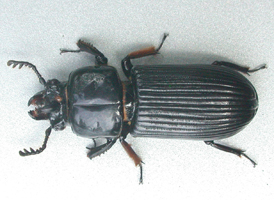 |
Bess Beetles
A single species in our area, identified by the strongly grooved wing cases, large jaws and obviously-divided body. Widespread in wooded areas.
|
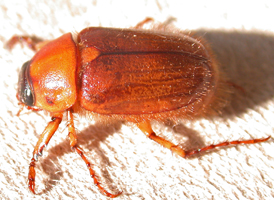 |
Scarab Beetles
A large and quite variable group of beetles, which includes the chafers, maybeetles and junebugs. They can be told by their furry bodies and rounded shape, as well as their branched antennae. Adults may be any shade of brown but more often have a rusty or chestnut tone to them; some are metallic green. Many species regularly come to light at night and may be abundant during the summer.
|
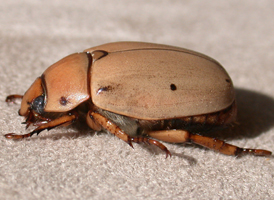 |
Scarab Beetles
A large and quite variable group of beetles, which includes the chafers, maybeetles and junebugs. Many of the larger species are hairy below but shiny and smooth above. These are chunky beetles - mostly larger than bumblebees, with some being among our largest insects. They are usually brownish, tan-colored or green, sometimes with darker markings.
|
 |
Scarab Beetles
A large and quite variable group of beetles, which includes the chafers, maybeetles and junebugs. Smaller scarab beetles include the flower beetles which are often somewhat hairy and come in a wide range of colors, from blackish and dark brown to metallic green. Flower beetles are usually rather square in outline and have elongated hind legs that are often held trailing out behind.
|
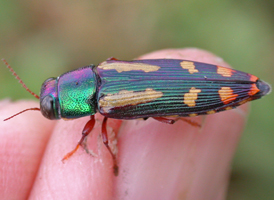 |
Jewel Beetles
This group of beetles is most readily identified from other beetles by the bullet-shaped body and the strong grooves in the wing cases. Many species are brightly-colored and have dazzling iridescence, but others are dark gray or blackish and blend in well on tree trunks.
|
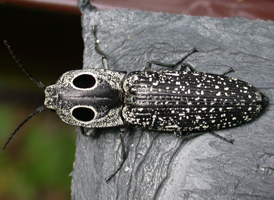 |
Click Beetles
A family of beetles that somewhat resemble the metallic wood-boring beetles in shape but, viewed side on, they can be seen to be clearly rather flattened in profile. Many species are rather small, plain brown and very difficult to identify to species, but some are more stikingly marked in pale gray and black.
|
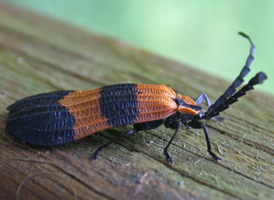 |
Net-winged Beetles
A relatively small family of usually black-and-yellow or black-and-red beetles. The surface of the wing cases have a 'netted' look to them, giving this family of beetles their English name.
|
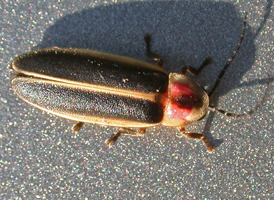 |
Fireflies
Small to medium-sized beetles with elongated, parallel-sided bodies. Most species are mostly dark grayish in color with patches of yellow or pinkish-red.
|
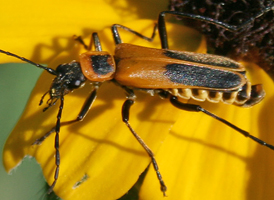 |
Soldier Beetles
Small to medium-sized beetles with elongated, parallel-sided bodies. Though some species are mostly dark in color, many are marked in bright yellow or orange. These are highly active, long-legged insects that often swarm over flowers in late summer.
|
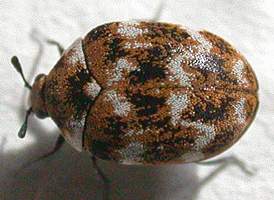 |
Dermestid Beetles
Small, oval-shaped beetles that are easily overlooked due to their often tiny size. Most species feed as indoor, household pests on woollen products, carpets and a range of stored foods, especially products of animal origin.
|
 |
Sap-feeding Beetles
A rather uninspiring group of small and sometimes difficult to identify beetles. Most species are rather plain, black, brown or chestnut-colored, but some have yellowish or orange markings.
|
 |
Lady Beetles
Distinctive and well-known small beetles - though most of the common and widespread species are introduced from Europe or Asia. The most familiar species are red with black spots, but some species may have orange or yellow as a background color, while others may be mostly black. Some members of the leaf beetle family can look quite similar to lady beetles and should always be considered when identifying small, brightly-colored beetles.
|
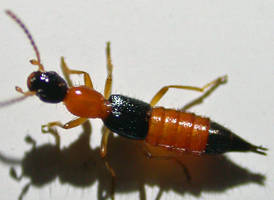 |
Rove Beetles
Slender, fast-moving beetles that run actively over the ground in search of prey. Some species take readily to flight if handled. Most species are either all black or black and red.
|
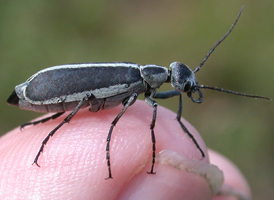 |
Blister Beetles
Heavy-bodied, long-legged, chunky beetles. May be all black and shiny, or marked with paler gray. Adults are usually found roaming on the ground.
|
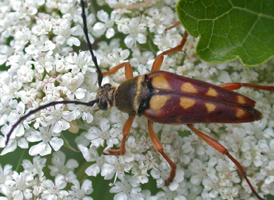 |
Long-horned Beetles
A large and very varied family of beetles, most easily recognized by their usually very long antennae. Some species are brightly colored, have tapered bodies and often somewhat resemble wasps. Flower longhorns tend to have smaller heads and narrower necks than other longhorns. They spend much time feeding at flowers.
|
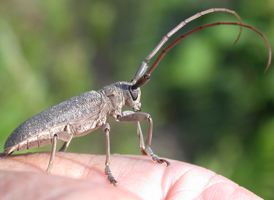 |
Long-horned Beetles
A large and very varied family of beetles, most easily recognized by their usually over-sized antennae. The wood-boring longhorns have the longest of the antennae in this group. Most species are gray or pale brown, with a variety of mottled markings; some are boldly striped in black or white.
|
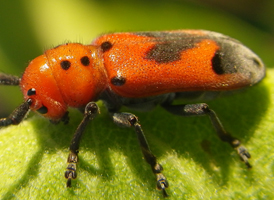 |
Milkweed Beetles
A small group of brightly orange-red and black, long-horned beetles that specialize in feeding on milkweed plants. The bright colors indicate to would-be predators that they are poisonous.
|
 |
Leaf Beetles
The leaf and flea beetles form part of a large family of often small and nondescript insects, many of which can cause damage to a variety of crops and garden plants. Larger species resemble over-sized lady beetles and come in a variety of often quite gaudy patterns or colors. Some species may be confused with chafers, but are hairless and have simple antennae.
|
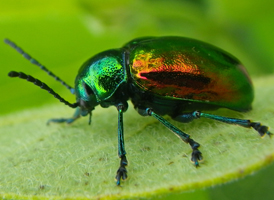 |
Leaf Beetles
The leaf and flea beetles form part of a large family of often small and nondescript insects, many of which can cause damage to a variety of crops and garden plants. Larger species resemble over-sized lady beetles and come in a variety of often quite gaudy patterns or colors. Some species may be confused with chafers, but are hairless and have simple antennae.
|
 |
Leaf Beetles
The leaf and flea beetles form part of a large family of often small and nondescript insects, many of which can cause damage to a variety of crops and garden plants. The smaller flea beetles are rather slender insects with small heads and relatively long antennae and legs. Some species have enlarged hind legs which allow them to spring rapidly away from danger. Some species are dull brown or blackish, while others can be quite brightly marked.
|
 |
Leaf-rolling Weevils
These are small and easily-overlooked weevils, but the rolled leaves that mark their presence can often been conspicuous. These are small, square-sided beetles with elongated snouts; they tend to be either black, dark brown or reddish in color.
|
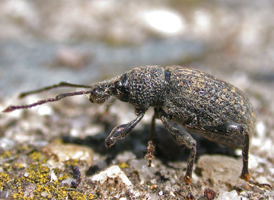 |
Weevils & Snout Beetles
A large family of often mottled, dark-colored beetles. Weevils are best told by their usually elongated snouts and antennae which have an 'elbow' in the middle.
|